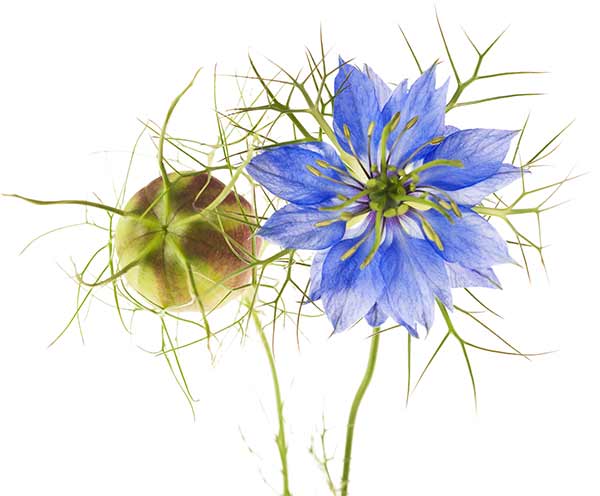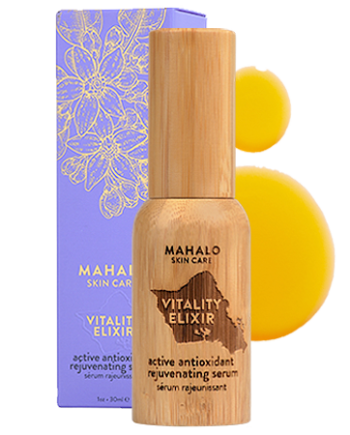I N R E D I E N T S P O T L I G H T || Inconspicuous in name, yet mighty in substance – Black Cumin seed oil.
Black Cumin Seed oil is a super star ingredient in our Vitality Elixir facial serum, and like all Mahalo’s ingredients, the oil used for our serum is of highest quality. Our organic Black Cumin seed oil is produced via supercritical fluid extraction with natural carbon dioxide. It contains no solvent residues, no inorganic salts, no heavy metals, no reproducible microorganisms. The proprietary supercritical CO2 extraction method delivers the purest, and most potent Black Cumin seed extract that retains the near-identical chemical profile of the raw plant.
Due to its miraculous power of healing, Black Cumin has got the place among the top ranked evidence based herbal medicines. Discover below why Mahalo LOVES it, and what having Black Cumin as part of your daily beauty skin care ritual will do to your skin.
Characteristics of the plant
The Black Cumin comes from a plant scientifically called Nigella Sativa, also known as black seed, and kalongi. Nigella Sativa is an annual flowering plant from the buttercup family which grows to 20-90 cm tall, with finely divided leaves, the leaf segments narrowly linear to threadlike. The flowers are delicate, and usually colored white, yellow, pink, pale blue or pale purple, with 5-10 petals. The fruit is a large and inflated capsule composed of 3-7 united follicles, each containing numerous seeds. Seeds of Nigella Sativa are black externally and white inside, odor slightly aromatic and taste bitter.

Nigella Sativa difference from other Black Cumin variaties
When it comes to medicinal properties of the plant, identifying correct variety is of utmost importance. Same like with Lavender, Rose, and Tansy, it is crucial to know what Black Cumin seed oil you are using. In this case, knowing it’s scientific, or Latin name clears it all up. It is important not to confuse Nigella Sativa with Bunium Bulbocastanum, Cuminum cyminum (common cumin seed) and other cumin seeds. Bunium Bulbocastanum, is most often confused with Nigella Sativa, as it is also known as Black Cumin in English, however it belongs to a completely different plant family, and has a distinctly different appearance, seeds, and lacks the medicinal properties of Nigella Sativa.
Bunium Bulbocastanum comes from plant species in the Apiaceae family, and is sometimes called black caraway. In appearance they resemble elongated white cumin seeds, but being a little bit more thinner and feathery (pictured right above). Nigella Sativa Black Cumin seeds look like small bits of black coal (pictured left above). The millenia-long ode to medicinal benefits of Black Cumin is attributed to Nigella Sativa.
So once again, read product information carefully. Black Cumin is commonly referred to as black seed oil, black onion seed, black caraway, black sesame seed, and other names, but only Nigella Sativa is the true Black Cumin.
Black Cumin Seed properties
The chemical composition of the black Nigella Sativa seed is diverse and packs a powerful punch of:
- over one hundred vitamins
- minerals (like Cu, P, Zn and Fe)
- essential fatty acids (mainly linoleic acid (50-60%)
- carotene
- flavonoids
- amino acids
- proteins
- carbohydrates
- fixed and volatile oils
- alkaloids
- saponins
- and many other compounds
Thin Layer Chromatography (TLC) screening of the oil samples showed the presence of four main components, viz. thymoquinone, carvacrol, tanethole and 4-terpineol, which demonstrated respectable radical scavenging property, and antioxidant activity.
Historical Use of Black Cumin Seed

Cultivated throughout Asia, Middle East and Africa, Black Cumin has been used since ancient times. Out of the several accompanying articles found in the tomb of Egyptian Pharaoh Tutankhamen (born circa 1340 BCE) were the seeds of Black Cumin. The historical references to these seeds are also found in some of the oldest religious and medical texts. For example, it is referred to as ‘Melanthion’ by Hippocrates and Dioscorides, while the Bible describes it as the ‘curative black cumin’ (Isaiah 28:25, 27 NKJV). It is, therefore, no wonder that they were thought to be worthy accompaniments in the ‘From Life here to Eternity’ by the Pharaoh.

In old Latin it is called as ‘Panacea’ meaning ‘cure all’ while in Arabic it is termed as ‘Habbah Sawda’ or ‘Habbat el Baraka’ translated as ‘Seeds of blessing’. In Islamic literature, it is considered as one of the greatest forms of healing medicine. According to a hadith of Islam, the Prophet Mohammed said, “the black granules (black seed) are the remedy for all diseases except death.” In India, kalonji Nigella Sativa seed and is an important drug in their traditional systems of medicine like Unani and Ayurveda. In China it is known as Hak Jung Chou.
Modern Clinical Research

The ancient wisdom of using Black Cumin oil for the treatment of human illnesses has caught the attention of the natural health, beauty, personal care industries, as well as clinical researches, and they continue to study and document the wide array of impressive nutritive properties and applications of Black Cumin oil and it’s constituents. Since 1959, there have been over 200 published articles supporting the traditional uses of Black Seeds. Specifically, the active compound found in black seed oil, viz. ThymoQuinone (TQ) has been clinically tested, and extensively studied for its efficacy against several diseases, as well as it’s potent anti-inflammatory, antimicrobial, and antioxidant properties.
TQ has been shown to exhibit antioxidant property through different mechanisms in several recent reports. It was shown to work as a scavenger of various reactive oxygen species, and was observed to decrease cellular oxidative stress by inducing glutathione.
The scientific research articles published so far have confirmed the pharmacological potential of Nigela Sativa seeds, its oil and extracts and some of its active principles, particularly TQ and alpha-hederin, possess remarkable in vitro and in vivo pharmacological activities against a large variety of diseases. Few of the activities that have been researched:
– Anti-fungal
– Antioxidant
– Anticancer
– Anti-inflammatory
Black Cumin’s Antibacterial Properties
Additionally, Black Cumin has been researched as a potent antibacterial agent. A research paper published in 2008 showed that black cumin seed oil was nearly as effective at fighting bacteria as many prescription antibiotics. In the experiment, varying strengths of black cumin oil were tested against different types of bacteria. For the control, researchers also tested the effectiveness of a number of popular antibiotics to see how well they worked against the same bacteria. The findings were nothing short of incredible. Out of 144 strains of bacteria, the researchers found that 97 of them were stopped in their tracks by black cumin seed oil. Black cumin was found to be even more effective than the antibiotics for treating certain types of bacteria.
Benefits to the skin
Black Cumin oil boasts luxurious benefits when applied topically, especially when oil is produced via the supercritical CO2 extraction method. It’s ability to restore vibrancy and youthful vitality to the skin is unparalleled to any other plant ingredients.
Praised for it’s potency at fighting bacteria that causes acne, rosacea, eczema, and other skin infections; as well as for being a potent moisturizing agent, and anti-aging booster.
In short, Black Cumin seed oil helps to:
- Promote and inhibit melanogenesis (melanin production) - Restore skin’s acid mantle - Heal scars, and prevent scar formation - Soothe inflammation and boost skin’s natural healing ability - Fight bacteria that causes acne - Being high in zinc, it fights infections and clears blemishes - Balance oily skin and clear clogged pores - Reduce the appearance of dark spots

Use of Nigella Sativa in MAHALO products
You will find Black Cumin Nigella Sativa as the fourth superstar ingredient in our Vitality Elixir facial serum, a long standing favorite among celebrities, aesteticians and people looking for the most nutrient-dense facial serum that works to product clear and visible results. The Vitality Elixir also features remarcable co-op growm Tamanu oil from Polynesia, as well as five supercritical CO2 extracts, finished with exquisite miracle essential oils of Corsican Helichrysum and Bulgarian Rose. Discover more here.
Share your thoughts on Black Cumin seed
We would love to hear from you. Let us know if you are familiar with the Black Cumin seed, or if this article helped you discover the possibilities of this miracle plant. How do you use it?

.








